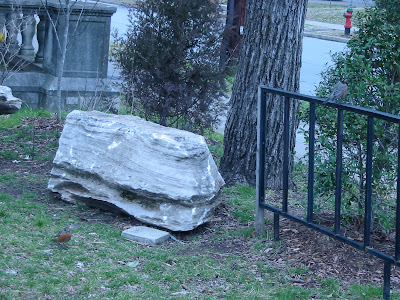The robins are here! For such a pretty and lovable bird, they have a very unflattering scientific name:
Turdus migratorius. The
migratorius part isn't so bad, and robins are indeed migratory birds. But why the name
Turdus? Scientific names are in Latin, and 'turdus' means 'thrush' in Latin, which is a bad deal for the robin. A thrush is a type of bird that is usually small and plump and searches for food on the ground. Bluebirds and wood thrushes are other common Middle Tennessee thrushes.
 |
| A male robin. |
Robins are grayish with rusty undersides. The males' heads are darker than their backs, and their underbellies are usually brighter than females'. Last week a male and female were getting to know each other at our outdoor classroom.
 |
| A female robin. |
In Nashville, this time of year robins are just finishing up their winter migration. Robins group together near the end of winter into massive flocks (did you notice them a couple weeks ago?), then they migrate to follow food sources and warm weather. They may not migrate straight north like most other migratory birds do - they just go wherever life is good for robins, which explains why we have some robins here year-round. At the end of the winter migration, birds form pairs and begin to find a home range to nest in. They may come back to the same place as last year, but they may not.
 |
| A female robin between the two Japanese quinces. |
Robins are generalists in both nesting and in feeding. They build nests in a variety of habitats, from landscaped yards to meadows to forests. They eat a variety of insects, worms and fruits, depending on what is available to them to eat. In the spring and summer, they tend to eat more insects, and in the fall and winter they eat more fruit and berries. This time of year, you are likely to see the cliché of a robin with a worm dangling from its beak. Robins can usually find their food and shelter requirements around where humans live, so they tend to be very familiar to us.
 |
| A female foraging for ground insects or worms and a male sitting on the fence. |
If the male and female I saw at our outdoor classroom become a pair, they will have 2-3 broods of baby robins this spring and summer. The female will soon start building a cup-shaped nest of three layers: twigs first then mud then grass on the inside. She will probably lay 3 light blue oblong eggs in the nest a couple of days after it is finished. The female sits on the nest for 12-14 days, getting up every once in a while to turn the eggs or go get food. The male might bring her some food or might not. The female's belly has a patch of skin with extra blood vessels that keep the eggs warm as she sits on them. If the eggs get too cold, they will die. When the eggs hatch, the female tosses the egg shells out of the nest and broods (sits) for another 3-4 days. After that, the hatchlings are able to keep themselves warm enough without being sat upon constantly.
Both parents feed the hatchlings after they escape their eggshells. For the first few days, the menu is regurgitated food the parents already ate. And if that isn't gross enough, after that the parents bring soft-bodied insects and worms to feed the poor little birds. The hatchlings beg and peep like mad for their food, so they must like it. Begging is an important skill for robin hatchlings, because the most aggressive peeper with the longest neck and widest-open beak will get the most food and is most likely to survive to adulthood.
At two weeks old, the robins usually fledge (leave the nest). They still don't fly well or know how to find food, so the parents hop around them on the ground alerting them to danger and bringing them insects and berries. At first, the mom feeds the fledglings, but then when they are starting to become independent, the dad will feed them, and the mom will go and build a new nest for the next brood. The fledgeling stage is very dangerous for the birds because the young ones can't fly yet. They might become the food that a mother hawk brings home to her hatchlings, or they might fall prey to a cat.
There are many types of birds at our outdoor classroom right now. Next time you go, try to count the different types of birds you see. Last time I was there, I saw 3 kinds. Pay special attention to the robins, and see if you can figure out what they are doing when you see them (feeding? gathering nest materials? searching for a good nest site? fighting off other birds? or are they watching you?).